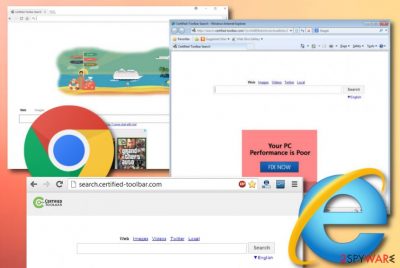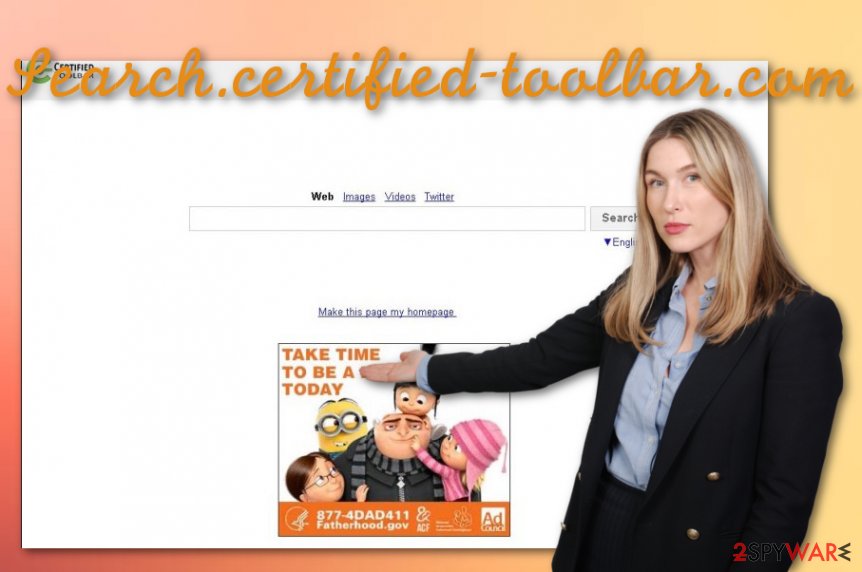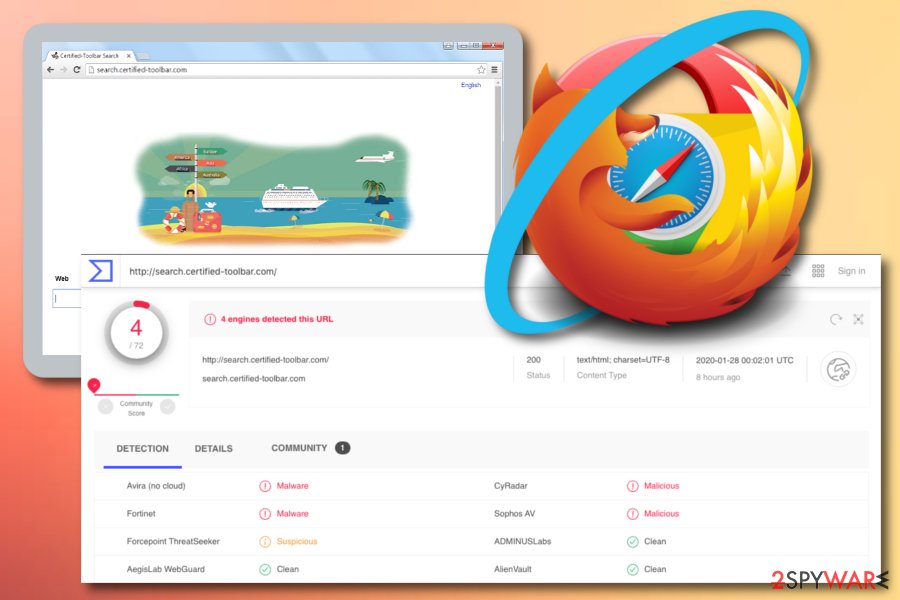Search.certified-toolbar.com (Improved Guide) - Virus Removal Instructions
Search.certified-toolbar.com Removal Guide
What is Search.certified-toolbar.com?
Search.certified-toolbar.com – a browser hijacker that alters new tab bar settings to open its own search page automatically

Search.certified-toolbar.com is a browser hijacker[1] that creates an image of a legitimate search engine. However, not everything is as harmless as it might seem from the first view. Even though technically, this PUP is not a dangerous malware form, it still performs some alterings and activities that are unpleasant or potentially malicious. Search certified toolbar can modify the Task Manager and Registry to drop its own load that allows executing the PUP whenever the machine is booted.
Continuously, Search.certified-toolbar.com virus can append the http://search.certified-toolbar.com?si=41460&shortcut=true&tid=2937 shortcut to your Windows desktop and Start bar. If you open a file that has this shortcut attached to it, you will be directly sent to the homepage of the browser hijacker.
The main purpose of certified search toolbar is to change the default search provider, homepage, and new tab URL bar to search.certified-toolbar.com. Afterward, the new settings will always appear while you open the hijacked web browser and even trying to set Google as your default provider again does not help to reverse the changes, according to one infected user.[2] Another dissatisfied person claims that this program has hijacked even two web browsers, the outlook mail account, and is very difficult to get rid of due to hiding in the computer system[3]
| Name | Search.certified-toolbar.com |
|---|---|
| Also known as | Search certified toolbar/certified search toolbar |
| Type/category | Browser hijacker/potentially unwanted program |
| Activities | This suspicious product alters major browser settings such as the homepage, new tab URL, and search zone. Continuously, the PUP adds odd shortcuts to the Windows desktop and start menu, provides intrusive advertisements, can redirect to affiliate and potentially dangerous sources, might collect non-personal information that is related to the user's browsing activities, habits, and experience |
| Spreading | Browser hijackers are often delivered by a stealth distribution technique known as “software bundling”. The PUP can come from rogue downloading sources such as cnet.com, download.com, softonic.com, or camouflage as legitimate-looking Adobe Flash Player, Java Script updates |
| Elimination | You can terminate the browser hijacker with the help of automatical malware removal software or by employing the manual step-by-step guidelines that have been appended to the end of this article |
| Fix tool | If you have found any signs of system compromisation, you can try repairing the corrupted areas with the help of software such as FortectIntego or any other automatical program that is reliable and you are likely to use |
The new search engine that is appended by Search.certified-toolbar.com will likely aim to generate search results from another legitimate search provider such as Google, Bing,[4] or Yahoo. Regarding this fact, the hijacked engine does not provide any true value to you and can bring more disadvantages than positive features.
Besides, Search.certified-toolbar.com can easily make you install its toolbar (Certified Toolbar) which is capable of showing altered search results. Even though the browser hijacker developers might try to convince you that their product is here to help you to search faster throughout the Internet, this is only a marketing trick used for “selling” the app.

Search certified toolbar also aims to produce intrusive advertisements while using its services. You can be provided with various online game offers, shopping deals, rogue security system products, urges to fix your poor computer performance, etc. Keep in mind that all of these offers and deals are income-based and created to satisfy the developers only.
Another bad side of Search.certified-toolbar.com is that it can produce advertisements that aim to redirect people to questionable-looking domains. Even though most of them will likely appear just filled with sponsored content, some of the websites might include malware-laden programs and bring serious harm to your computer system.
Finally, just like other questionable search engines, Search.certified-toolbar.com may start tracking your browsing habits and online experience. Typically, it collects search terms, mostly visited websites, data that is added when visiting each of the user's favorite sites and so on. Typically, this information is considered as personally non-identifiable.
However, it may be used for unfair marketing companies and similar aims. Search.certified-toolbar.com might use the gathered information for sharing it with other parties for more monetary income. Also, the developers can employ this type of data to “work” for them and let them benefit from targeted advertising campaigns.

That is why we would like to offer you to remove Search.certified-toolbar.com. If it has shown up on your computer without your approval, you should use the manual guide below or employ trustworthy antimalware software. This will help you to get rid of all potentially unwanted programs, like browser hijackers, adware, and similar intruders. Also, you can try out another piece of software such as FortectIntego that might help you to fix all compromised entries on your machine.
Search.certified-toolbar.com removal has to be completed in all the sections that the browser hijacker when through. This includes various directories of your Windows or Mac machine, and also possibly-infected web browser applications such as Google Chrome, Mozilla Firefox, Internet Explorer, Microsoft Edge, and Safari.
Ways through which browser hijackers enter devices
Cybersecurity specialists from NoVirus.uk[5] claim that browser hijackers are distributed by using stealth techniques such as “software bundling”. This type of process succeeds when the PUP is downloaded together with some type of freeware or shareware of the Internet. Users are likely to receive a browser hijacker while downloading various PDF converters, download managers, and similar products from third-party sources such as cnet.com, download.com, and softonic.com.
What you have to do in order to prevent secret browser hijacker installation is very simple. First, always take care of your downloads and installations properly. This means pay attention to every step while you are downloading/installing a program and do not skip any. Afterward, ensure that you have chosen the right configuration settings. Always use those that are marked as “custom” or “advanced” and do not forget to deselect all questionable incoming products.
Furthermore, browser hijackers can pretend to be legitimate software updates (e.g. JavaScript, Adobe Flash Player, etc.) and trick users into upgrading some type of program when, in reality, he/she receives the potentially unwanted program instead. Always be careful while downloading updates from the Internet. You are advised to get them from the software's original website. Also, use antivirus software that will warn you if something suspicious is waiting on a certain website.
Search.certified-toolbar.com removal instructions
Search.certified-toolbar.com removal is necessary if you want to get rid of all the unexpected changes that the browser hijacker has initiated on your web browsers. Completely removing the threat is the only way to clean both your operating system and browsing apps. If you leave any questionable registries or files on your computer, the browser-hijacking application might automatically launch itself within the next machine boot process.
If you want to remove Search.certified-toolbar.com by yourself, we have provided specific step-by-step guidelines at the end of this article that should help you to clean your Windows/macOS computer system and web browser apps such as Chrome, Firefox, Explorer, Edge, and Safari. Alternatively, you can download trustworthy malware removal software and successfully get rid of the cyber threat automatically. Note that using antimalware programs is very recommendable as it requires less of the user's effort and can bring even more efficiency to the process.
You may remove virus damage with a help of FortectIntego. SpyHunter 5Combo Cleaner and Malwarebytes are recommended to detect potentially unwanted programs and viruses with all their files and registry entries that are related to them.
Getting rid of Search.certified-toolbar.com. Follow these steps
Uninstall from Windows
To terminate the browser hijacker from your Windows computer system and get rid of all the additional products that it has brought, apply the following guiding steps
Instructions for Windows 10/8 machines:
- Enter Control Panel into Windows search box and hit Enter or click on the search result.
- Under Programs, select Uninstall a program.

- From the list, find the entry of the suspicious program.
- Right-click on the application and select Uninstall.
- If User Account Control shows up, click Yes.
- Wait till uninstallation process is complete and click OK.

If you are Windows 7/XP user, proceed with the following instructions:
- Click on Windows Start > Control Panel located on the right pane (if you are Windows XP user, click on Add/Remove Programs).
- In Control Panel, select Programs > Uninstall a program.

- Pick the unwanted application by clicking on it once.
- At the top, click Uninstall/Change.
- In the confirmation prompt, pick Yes.
- Click OK once the removal process is finished.
Delete from macOS
Remove items from Applications folder:
- From the menu bar, select Go > Applications.
- In the Applications folder, look for all related entries.
- Click on the app and drag it to Trash (or right-click and pick Move to Trash)

To fully remove an unwanted app, you need to access Application Support, LaunchAgents, and LaunchDaemons folders and delete relevant files:
- Select Go > Go to Folder.
- Enter /Library/Application Support and click Go or press Enter.
- In the Application Support folder, look for any dubious entries and then delete them.
- Now enter /Library/LaunchAgents and /Library/LaunchDaemons folders the same way and terminate all the related .plist files.

Remove from Microsoft Edge
Delete unwanted extensions from MS Edge:
- Select Menu (three horizontal dots at the top-right of the browser window) and pick Extensions.
- From the list, pick the extension and click on the Gear icon.
- Click on Uninstall at the bottom.

Clear cookies and other browser data:
- Click on the Menu (three horizontal dots at the top-right of the browser window) and select Privacy & security.
- Under Clear browsing data, pick Choose what to clear.
- Select everything (apart from passwords, although you might want to include Media licenses as well, if applicable) and click on Clear.

Restore new tab and homepage settings:
- Click the menu icon and choose Settings.
- Then find On startup section.
- Click Disable if you found any suspicious domain.
Reset MS Edge if the above steps did not work:
- Press on Ctrl + Shift + Esc to open Task Manager.
- Click on More details arrow at the bottom of the window.
- Select Details tab.
- Now scroll down and locate every entry with Microsoft Edge name in it. Right-click on each of them and select End Task to stop MS Edge from running.

If this solution failed to help you, you need to use an advanced Edge reset method. Note that you need to backup your data before proceeding.
- Find the following folder on your computer: C:\\Users\\%username%\\AppData\\Local\\Packages\\Microsoft.MicrosoftEdge_8wekyb3d8bbwe.
- Press Ctrl + A on your keyboard to select all folders.
- Right-click on them and pick Delete

- Now right-click on the Start button and pick Windows PowerShell (Admin).
- When the new window opens, copy and paste the following command, and then press Enter:
Get-AppXPackage -AllUsers -Name Microsoft.MicrosoftEdge | Foreach {Add-AppxPackage -DisableDevelopmentMode -Register “$($_.InstallLocation)\\AppXManifest.xml” -Verbose

Instructions for Chromium-based Edge
Delete extensions from MS Edge (Chromium):
- Open Edge and click select Settings > Extensions.
- Delete unwanted extensions by clicking Remove.

Clear cache and site data:
- Click on Menu and go to Settings.
- Select Privacy, search and services.
- Under Clear browsing data, pick Choose what to clear.
- Under Time range, pick All time.
- Select Clear now.

Reset Chromium-based MS Edge:
- Click on Menu and select Settings.
- On the left side, pick Reset settings.
- Select Restore settings to their default values.
- Confirm with Reset.

Remove from Mozilla Firefox (FF)
Remove dangerous extensions:
- Open Mozilla Firefox browser and click on the Menu (three horizontal lines at the top-right of the window).
- Select Add-ons.
- In here, select unwanted plugin and click Remove.

Reset the homepage:
- Click three horizontal lines at the top right corner to open the menu.
- Choose Options.
- Under Home options, enter your preferred site that will open every time you newly open the Mozilla Firefox.
Clear cookies and site data:
- Click Menu and pick Settings.
- Go to Privacy & Security section.
- Scroll down to locate Cookies and Site Data.
- Click on Clear Data…
- Select Cookies and Site Data, as well as Cached Web Content and press Clear.

Reset Mozilla Firefox
If clearing the browser as explained above did not help, reset Mozilla Firefox:
- Open Mozilla Firefox browser and click the Menu.
- Go to Help and then choose Troubleshooting Information.

- Under Give Firefox a tune up section, click on Refresh Firefox…
- Once the pop-up shows up, confirm the action by pressing on Refresh Firefox.

Remove from Google Chrome
To erase suspicious extensions from Google Chrome and reverse your web browser back to its previous position, complete the following instructions
Delete malicious extensions from Google Chrome:
- Open Google Chrome, click on the Menu (three vertical dots at the top-right corner) and select More tools > Extensions.
- In the newly opened window, you will see all the installed extensions. Uninstall all the suspicious plugins that might be related to the unwanted program by clicking Remove.

Clear cache and web data from Chrome:
- Click on Menu and pick Settings.
- Under Privacy and security, select Clear browsing data.
- Select Browsing history, Cookies and other site data, as well as Cached images and files.
- Click Clear data.

Change your homepage:
- Click menu and choose Settings.
- Look for a suspicious site in the On startup section.
- Click on Open a specific or set of pages and click on three dots to find the Remove option.
Reset Google Chrome:
If the previous methods did not help you, reset Google Chrome to eliminate all the unwanted components:
- Click on Menu and select Settings.
- In the Settings, scroll down and click Advanced.
- Scroll down and locate Reset and clean up section.
- Now click Restore settings to their original defaults.
- Confirm with Reset settings.

Delete from Safari
Remove unwanted extensions from Safari:
- Click Safari > Preferences…
- In the new window, pick Extensions.
- Select the unwanted extension and select Uninstall.

Clear cookies and other website data from Safari:
- Click Safari > Clear History…
- From the drop-down menu under Clear, pick all history.
- Confirm with Clear History.

Reset Safari if the above-mentioned steps did not help you:
- Click Safari > Preferences…
- Go to Advanced tab.
- Tick the Show Develop menu in menu bar.
- From the menu bar, click Develop, and then select Empty Caches.

After uninstalling this potentially unwanted program (PUP) and fixing each of your web browsers, we recommend you to scan your PC system with a reputable anti-spyware. This will help you to get rid of Search.certified-toolbar.com registry traces and will also identify related parasites or possible malware infections on your computer. For that you can use our top-rated malware remover: FortectIntego, SpyHunter 5Combo Cleaner or Malwarebytes.
How to prevent from getting browser hijacker
Stream videos without limitations, no matter where you are
There are multiple parties that could find out almost anything about you by checking your online activity. While this is highly unlikely, advertisers and tech companies are constantly tracking you online. The first step to privacy should be a secure browser that focuses on tracker reduction to a minimum.
Even if you employ a secure browser, you will not be able to access websites that are restricted due to local government laws or other reasons. In other words, you may not be able to stream Disney+ or US-based Netflix in some countries. To bypass these restrictions, you can employ a powerful Private Internet Access VPN, which provides dedicated servers for torrenting and streaming, not slowing you down in the process.
Data backups are important – recover your lost files
Ransomware is one of the biggest threats to personal data. Once it is executed on a machine, it launches a sophisticated encryption algorithm that locks all your files, although it does not destroy them. The most common misconception is that anti-malware software can return files to their previous states. This is not true, however, and data remains locked after the malicious payload is deleted.
While regular data backups are the only secure method to recover your files after a ransomware attack, tools such as Data Recovery Pro can also be effective and restore at least some of your lost data.
- ^ What are browser hijackers?. Norton. Internet Security.
- ^ miche109. search certified toolbar. Norton Community. Discussion Forums.
- ^ StratosMahmourides. search.certified-toolbar.com to delete. Microsoft Answers. Forums.
- ^ Bing (search engine). Wikipedia. The free encyclopedia.
- ^ NoVirus. NoVirus.uk. Security and spyware news.























